Effectiveness of HIV/AIDS Interventions in Sub-Saharan Africa
VerifiedAdded on 2022/08/22
|12
|4694
|22
Essay
AI Summary
This essay critically examines the challenges associated with HIV/AIDS interventions in Sub-Saharan Africa, focusing on meeting the goals outlined in the SDG agenda. It explores the disproportionate burden of HIV in the region, the factors that increase vulnerability, and the various interventions employed to reduce death rates, including antiretroviral therapy (ART), behavioral changes, and biomedical approaches like male circumcision. The essay discusses the effectiveness of these interventions, the challenges in their implementation, and the role of programs like pre-exposure prophylaxis (PrEP) and voluntary medical male circumcision (VMMC). It emphasizes the importance of comprehensive testing programs, universal access to ART, and the need for ongoing research to develop more effective strategies for mitigating the negative impacts of the epidemic and achieving the targets set by UNAIDS for reducing HIV infections.

RUNNING HEAD: HIV AIDS IN SUB-SAHARAN AFRICA 0
2020
HIV/AIDS in Sub-Saharan Africa
Student’s DEtails-
2020
HIV/AIDS in Sub-Saharan Africa
Student’s DEtails-
Paraphrase This Document
Need a fresh take? Get an instant paraphrase of this document with our AI Paraphraser
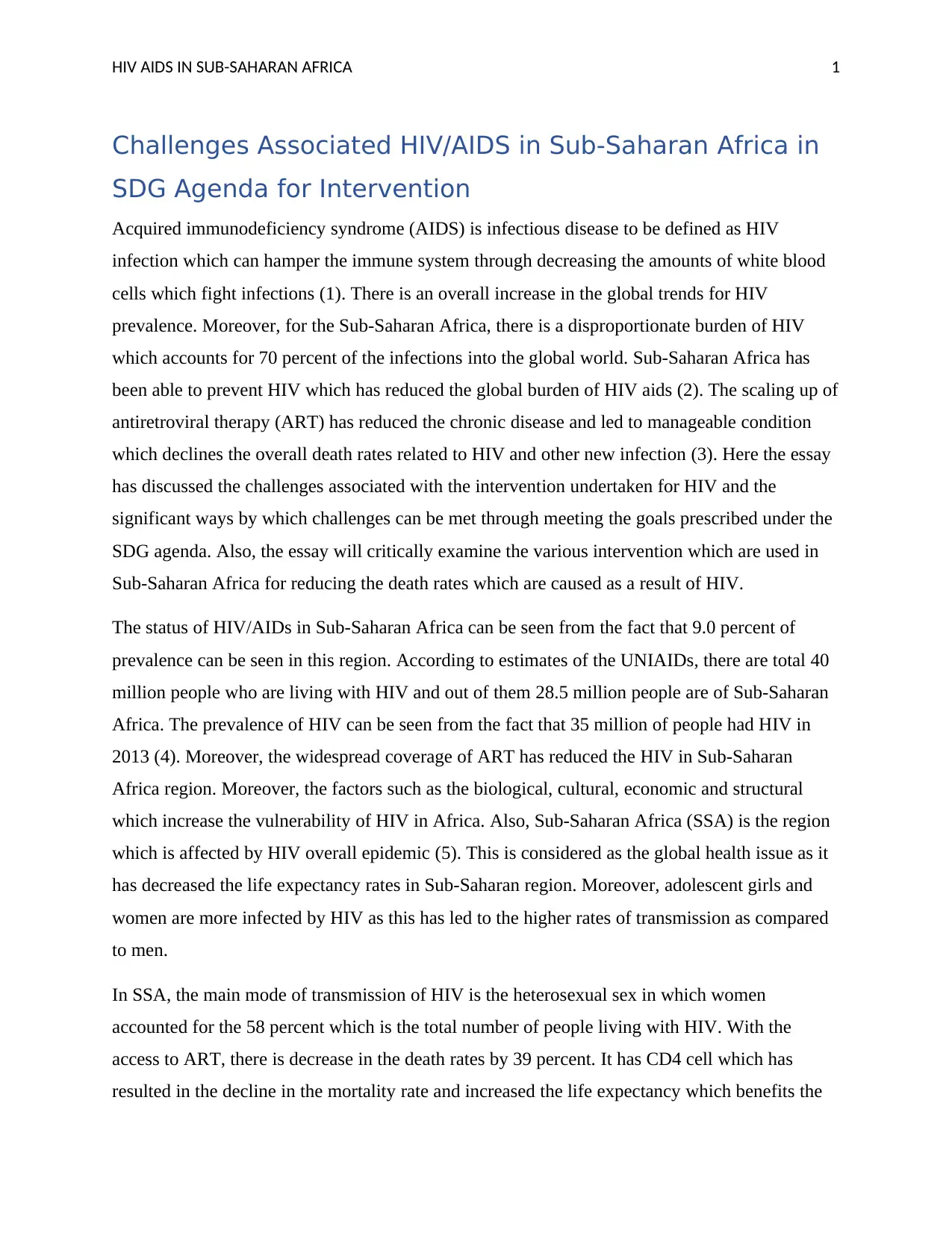
HIV AIDS IN SUB-SAHARAN AFRICA 1
Challenges Associated HIV/AIDS in Sub-Saharan Africa in
SDG Agenda for Intervention
Acquired immunodeficiency syndrome (AIDS) is infectious disease to be defined as HIV
infection which can hamper the immune system through decreasing the amounts of white blood
cells which fight infections (1). There is an overall increase in the global trends for HIV
prevalence. Moreover, for the Sub-Saharan Africa, there is a disproportionate burden of HIV
which accounts for 70 percent of the infections into the global world. Sub-Saharan Africa has
been able to prevent HIV which has reduced the global burden of HIV aids (2). The scaling up of
antiretroviral therapy (ART) has reduced the chronic disease and led to manageable condition
which declines the overall death rates related to HIV and other new infection (3). Here the essay
has discussed the challenges associated with the intervention undertaken for HIV and the
significant ways by which challenges can be met through meeting the goals prescribed under the
SDG agenda. Also, the essay will critically examine the various intervention which are used in
Sub-Saharan Africa for reducing the death rates which are caused as a result of HIV.
The status of HIV/AIDs in Sub-Saharan Africa can be seen from the fact that 9.0 percent of
prevalence can be seen in this region. According to estimates of the UNIAIDs, there are total 40
million people who are living with HIV and out of them 28.5 million people are of Sub-Saharan
Africa. The prevalence of HIV can be seen from the fact that 35 million of people had HIV in
2013 (4). Moreover, the widespread coverage of ART has reduced the HIV in Sub-Saharan
Africa region. Moreover, the factors such as the biological, cultural, economic and structural
which increase the vulnerability of HIV in Africa. Also, Sub-Saharan Africa (SSA) is the region
which is affected by HIV overall epidemic (5). This is considered as the global health issue as it
has decreased the life expectancy rates in Sub-Saharan region. Moreover, adolescent girls and
women are more infected by HIV as this has led to the higher rates of transmission as compared
to men.
In SSA, the main mode of transmission of HIV is the heterosexual sex in which women
accounted for the 58 percent which is the total number of people living with HIV. With the
access to ART, there is decrease in the death rates by 39 percent. It has CD4 cell which has
resulted in the decline in the mortality rate and increased the life expectancy which benefits the
Challenges Associated HIV/AIDS in Sub-Saharan Africa in
SDG Agenda for Intervention
Acquired immunodeficiency syndrome (AIDS) is infectious disease to be defined as HIV
infection which can hamper the immune system through decreasing the amounts of white blood
cells which fight infections (1). There is an overall increase in the global trends for HIV
prevalence. Moreover, for the Sub-Saharan Africa, there is a disproportionate burden of HIV
which accounts for 70 percent of the infections into the global world. Sub-Saharan Africa has
been able to prevent HIV which has reduced the global burden of HIV aids (2). The scaling up of
antiretroviral therapy (ART) has reduced the chronic disease and led to manageable condition
which declines the overall death rates related to HIV and other new infection (3). Here the essay
has discussed the challenges associated with the intervention undertaken for HIV and the
significant ways by which challenges can be met through meeting the goals prescribed under the
SDG agenda. Also, the essay will critically examine the various intervention which are used in
Sub-Saharan Africa for reducing the death rates which are caused as a result of HIV.
The status of HIV/AIDs in Sub-Saharan Africa can be seen from the fact that 9.0 percent of
prevalence can be seen in this region. According to estimates of the UNIAIDs, there are total 40
million people who are living with HIV and out of them 28.5 million people are of Sub-Saharan
Africa. The prevalence of HIV can be seen from the fact that 35 million of people had HIV in
2013 (4). Moreover, the widespread coverage of ART has reduced the HIV in Sub-Saharan
Africa region. Moreover, the factors such as the biological, cultural, economic and structural
which increase the vulnerability of HIV in Africa. Also, Sub-Saharan Africa (SSA) is the region
which is affected by HIV overall epidemic (5). This is considered as the global health issue as it
has decreased the life expectancy rates in Sub-Saharan region. Moreover, adolescent girls and
women are more infected by HIV as this has led to the higher rates of transmission as compared
to men.
In SSA, the main mode of transmission of HIV is the heterosexual sex in which women
accounted for the 58 percent which is the total number of people living with HIV. With the
access to ART, there is decrease in the death rates by 39 percent. It has CD4 cell which has
resulted in the decline in the mortality rate and increased the life expectancy which benefits the
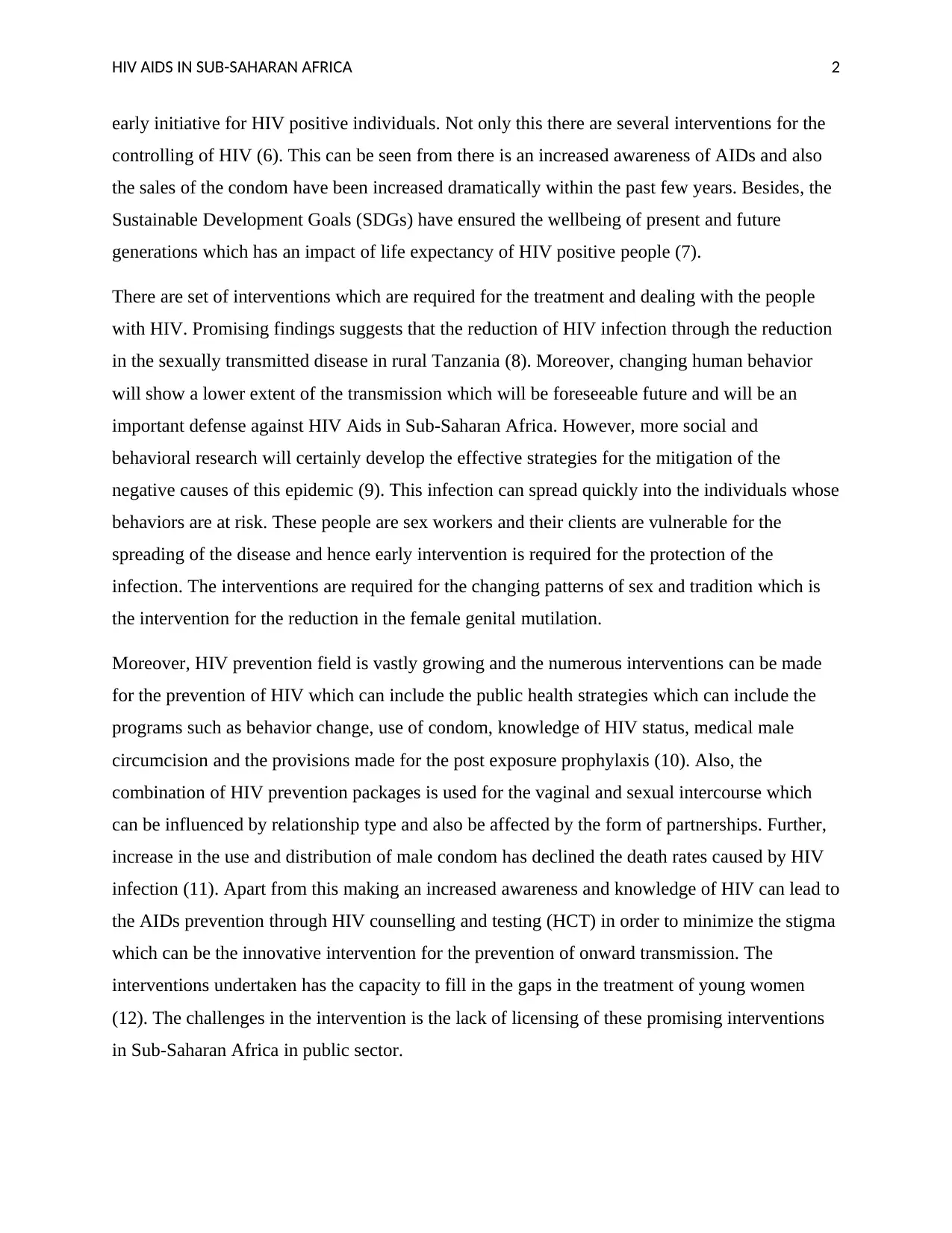
HIV AIDS IN SUB-SAHARAN AFRICA 2
early initiative for HIV positive individuals. Not only this there are several interventions for the
controlling of HIV (6). This can be seen from there is an increased awareness of AIDs and also
the sales of the condom have been increased dramatically within the past few years. Besides, the
Sustainable Development Goals (SDGs) have ensured the wellbeing of present and future
generations which has an impact of life expectancy of HIV positive people (7).
There are set of interventions which are required for the treatment and dealing with the people
with HIV. Promising findings suggests that the reduction of HIV infection through the reduction
in the sexually transmitted disease in rural Tanzania (8). Moreover, changing human behavior
will show a lower extent of the transmission which will be foreseeable future and will be an
important defense against HIV Aids in Sub-Saharan Africa. However, more social and
behavioral research will certainly develop the effective strategies for the mitigation of the
negative causes of this epidemic (9). This infection can spread quickly into the individuals whose
behaviors are at risk. These people are sex workers and their clients are vulnerable for the
spreading of the disease and hence early intervention is required for the protection of the
infection. The interventions are required for the changing patterns of sex and tradition which is
the intervention for the reduction in the female genital mutilation.
Moreover, HIV prevention field is vastly growing and the numerous interventions can be made
for the prevention of HIV which can include the public health strategies which can include the
programs such as behavior change, use of condom, knowledge of HIV status, medical male
circumcision and the provisions made for the post exposure prophylaxis (10). Also, the
combination of HIV prevention packages is used for the vaginal and sexual intercourse which
can be influenced by relationship type and also be affected by the form of partnerships. Further,
increase in the use and distribution of male condom has declined the death rates caused by HIV
infection (11). Apart from this making an increased awareness and knowledge of HIV can lead to
the AIDs prevention through HIV counselling and testing (HCT) in order to minimize the stigma
which can be the innovative intervention for the prevention of onward transmission. The
interventions undertaken has the capacity to fill in the gaps in the treatment of young women
(12). The challenges in the intervention is the lack of licensing of these promising interventions
in Sub-Saharan Africa in public sector.
early initiative for HIV positive individuals. Not only this there are several interventions for the
controlling of HIV (6). This can be seen from there is an increased awareness of AIDs and also
the sales of the condom have been increased dramatically within the past few years. Besides, the
Sustainable Development Goals (SDGs) have ensured the wellbeing of present and future
generations which has an impact of life expectancy of HIV positive people (7).
There are set of interventions which are required for the treatment and dealing with the people
with HIV. Promising findings suggests that the reduction of HIV infection through the reduction
in the sexually transmitted disease in rural Tanzania (8). Moreover, changing human behavior
will show a lower extent of the transmission which will be foreseeable future and will be an
important defense against HIV Aids in Sub-Saharan Africa. However, more social and
behavioral research will certainly develop the effective strategies for the mitigation of the
negative causes of this epidemic (9). This infection can spread quickly into the individuals whose
behaviors are at risk. These people are sex workers and their clients are vulnerable for the
spreading of the disease and hence early intervention is required for the protection of the
infection. The interventions are required for the changing patterns of sex and tradition which is
the intervention for the reduction in the female genital mutilation.
Moreover, HIV prevention field is vastly growing and the numerous interventions can be made
for the prevention of HIV which can include the public health strategies which can include the
programs such as behavior change, use of condom, knowledge of HIV status, medical male
circumcision and the provisions made for the post exposure prophylaxis (10). Also, the
combination of HIV prevention packages is used for the vaginal and sexual intercourse which
can be influenced by relationship type and also be affected by the form of partnerships. Further,
increase in the use and distribution of male condom has declined the death rates caused by HIV
infection (11). Apart from this making an increased awareness and knowledge of HIV can lead to
the AIDs prevention through HIV counselling and testing (HCT) in order to minimize the stigma
which can be the innovative intervention for the prevention of onward transmission. The
interventions undertaken has the capacity to fill in the gaps in the treatment of young women
(12). The challenges in the intervention is the lack of licensing of these promising interventions
in Sub-Saharan Africa in public sector.
⊘ This is a preview!⊘
Do you want full access?
Subscribe today to unlock all pages.

Trusted by 1+ million students worldwide
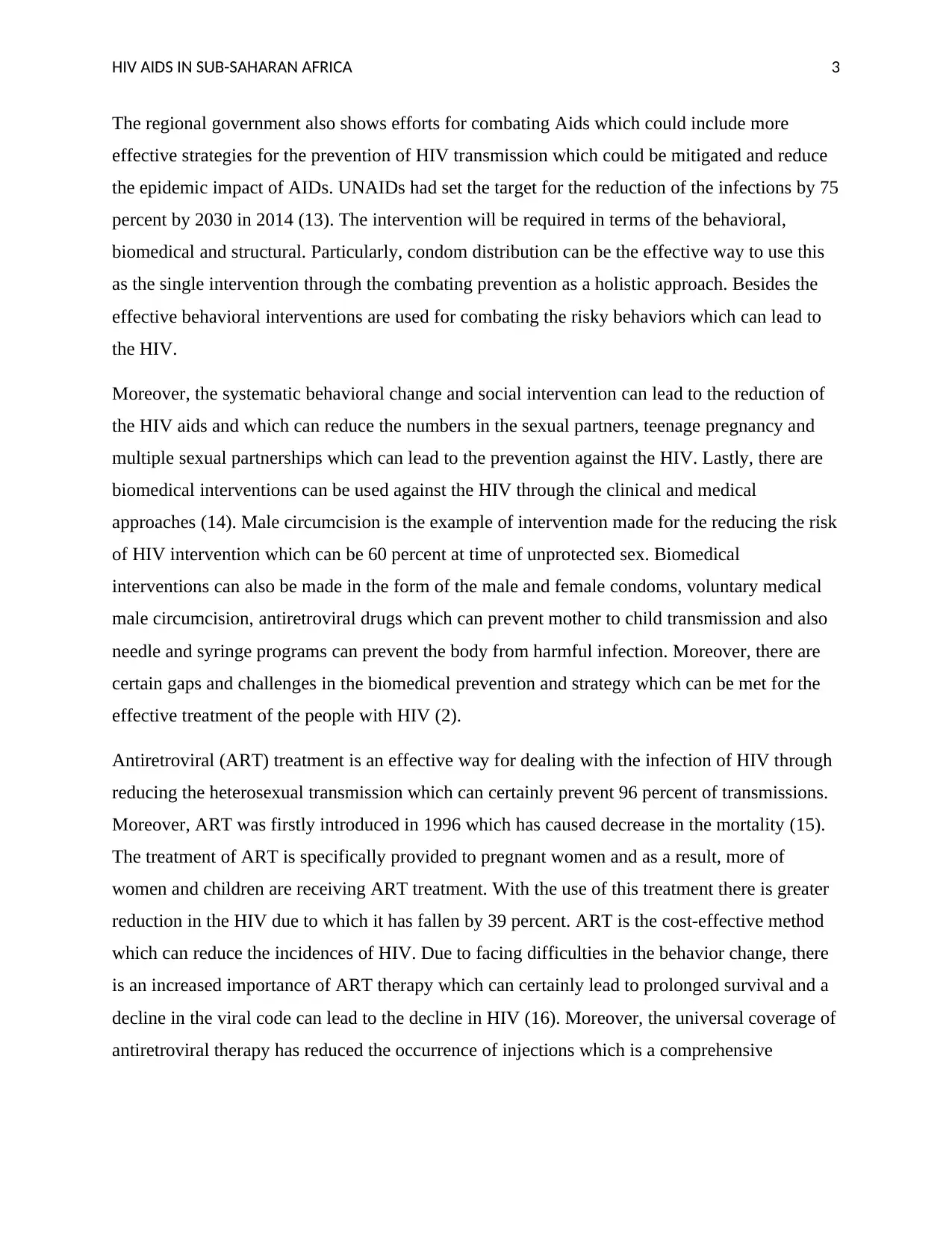
HIV AIDS IN SUB-SAHARAN AFRICA 3
The regional government also shows efforts for combating Aids which could include more
effective strategies for the prevention of HIV transmission which could be mitigated and reduce
the epidemic impact of AIDs. UNAIDs had set the target for the reduction of the infections by 75
percent by 2030 in 2014 (13). The intervention will be required in terms of the behavioral,
biomedical and structural. Particularly, condom distribution can be the effective way to use this
as the single intervention through the combating prevention as a holistic approach. Besides the
effective behavioral interventions are used for combating the risky behaviors which can lead to
the HIV.
Moreover, the systematic behavioral change and social intervention can lead to the reduction of
the HIV aids and which can reduce the numbers in the sexual partners, teenage pregnancy and
multiple sexual partnerships which can lead to the prevention against the HIV. Lastly, there are
biomedical interventions can be used against the HIV through the clinical and medical
approaches (14). Male circumcision is the example of intervention made for the reducing the risk
of HIV intervention which can be 60 percent at time of unprotected sex. Biomedical
interventions can also be made in the form of the male and female condoms, voluntary medical
male circumcision, antiretroviral drugs which can prevent mother to child transmission and also
needle and syringe programs can prevent the body from harmful infection. Moreover, there are
certain gaps and challenges in the biomedical prevention and strategy which can be met for the
effective treatment of the people with HIV (2).
Antiretroviral (ART) treatment is an effective way for dealing with the infection of HIV through
reducing the heterosexual transmission which can certainly prevent 96 percent of transmissions.
Moreover, ART was firstly introduced in 1996 which has caused decrease in the mortality (15).
The treatment of ART is specifically provided to pregnant women and as a result, more of
women and children are receiving ART treatment. With the use of this treatment there is greater
reduction in the HIV due to which it has fallen by 39 percent. ART is the cost-effective method
which can reduce the incidences of HIV. Due to facing difficulties in the behavior change, there
is an increased importance of ART therapy which can certainly lead to prolonged survival and a
decline in the viral code can lead to the decline in HIV (16). Moreover, the universal coverage of
antiretroviral therapy has reduced the occurrence of injections which is a comprehensive
The regional government also shows efforts for combating Aids which could include more
effective strategies for the prevention of HIV transmission which could be mitigated and reduce
the epidemic impact of AIDs. UNAIDs had set the target for the reduction of the infections by 75
percent by 2030 in 2014 (13). The intervention will be required in terms of the behavioral,
biomedical and structural. Particularly, condom distribution can be the effective way to use this
as the single intervention through the combating prevention as a holistic approach. Besides the
effective behavioral interventions are used for combating the risky behaviors which can lead to
the HIV.
Moreover, the systematic behavioral change and social intervention can lead to the reduction of
the HIV aids and which can reduce the numbers in the sexual partners, teenage pregnancy and
multiple sexual partnerships which can lead to the prevention against the HIV. Lastly, there are
biomedical interventions can be used against the HIV through the clinical and medical
approaches (14). Male circumcision is the example of intervention made for the reducing the risk
of HIV intervention which can be 60 percent at time of unprotected sex. Biomedical
interventions can also be made in the form of the male and female condoms, voluntary medical
male circumcision, antiretroviral drugs which can prevent mother to child transmission and also
needle and syringe programs can prevent the body from harmful infection. Moreover, there are
certain gaps and challenges in the biomedical prevention and strategy which can be met for the
effective treatment of the people with HIV (2).
Antiretroviral (ART) treatment is an effective way for dealing with the infection of HIV through
reducing the heterosexual transmission which can certainly prevent 96 percent of transmissions.
Moreover, ART was firstly introduced in 1996 which has caused decrease in the mortality (15).
The treatment of ART is specifically provided to pregnant women and as a result, more of
women and children are receiving ART treatment. With the use of this treatment there is greater
reduction in the HIV due to which it has fallen by 39 percent. ART is the cost-effective method
which can reduce the incidences of HIV. Due to facing difficulties in the behavior change, there
is an increased importance of ART therapy which can certainly lead to prolonged survival and a
decline in the viral code can lead to the decline in HIV (16). Moreover, the universal coverage of
antiretroviral therapy has reduced the occurrence of injections which is a comprehensive
Paraphrase This Document
Need a fresh take? Get an instant paraphrase of this document with our AI Paraphraser
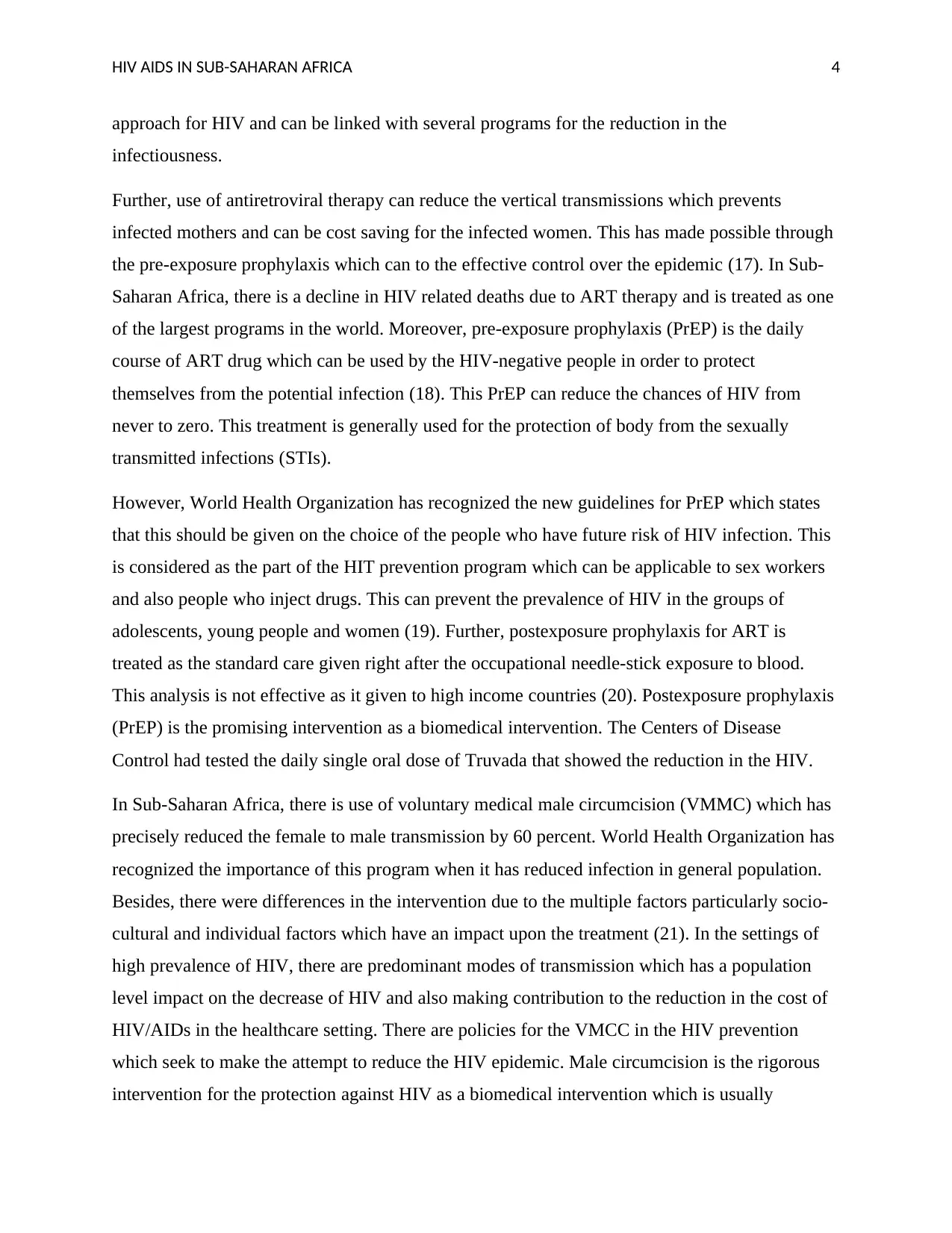
HIV AIDS IN SUB-SAHARAN AFRICA 4
approach for HIV and can be linked with several programs for the reduction in the
infectiousness.
Further, use of antiretroviral therapy can reduce the vertical transmissions which prevents
infected mothers and can be cost saving for the infected women. This has made possible through
the pre-exposure prophylaxis which can to the effective control over the epidemic (17). In Sub-
Saharan Africa, there is a decline in HIV related deaths due to ART therapy and is treated as one
of the largest programs in the world. Moreover, pre-exposure prophylaxis (PrEP) is the daily
course of ART drug which can be used by the HIV-negative people in order to protect
themselves from the potential infection (18). This PrEP can reduce the chances of HIV from
never to zero. This treatment is generally used for the protection of body from the sexually
transmitted infections (STIs).
However, World Health Organization has recognized the new guidelines for PrEP which states
that this should be given on the choice of the people who have future risk of HIV infection. This
is considered as the part of the HIT prevention program which can be applicable to sex workers
and also people who inject drugs. This can prevent the prevalence of HIV in the groups of
adolescents, young people and women (19). Further, postexposure prophylaxis for ART is
treated as the standard care given right after the occupational needle-stick exposure to blood.
This analysis is not effective as it given to high income countries (20). Postexposure prophylaxis
(PrEP) is the promising intervention as a biomedical intervention. The Centers of Disease
Control had tested the daily single oral dose of Truvada that showed the reduction in the HIV.
In Sub-Saharan Africa, there is use of voluntary medical male circumcision (VMMC) which has
precisely reduced the female to male transmission by 60 percent. World Health Organization has
recognized the importance of this program when it has reduced infection in general population.
Besides, there were differences in the intervention due to the multiple factors particularly socio-
cultural and individual factors which have an impact upon the treatment (21). In the settings of
high prevalence of HIV, there are predominant modes of transmission which has a population
level impact on the decrease of HIV and also making contribution to the reduction in the cost of
HIV/AIDs in the healthcare setting. There are policies for the VMCC in the HIV prevention
which seek to make the attempt to reduce the HIV epidemic. Male circumcision is the rigorous
intervention for the protection against HIV as a biomedical intervention which is usually
approach for HIV and can be linked with several programs for the reduction in the
infectiousness.
Further, use of antiretroviral therapy can reduce the vertical transmissions which prevents
infected mothers and can be cost saving for the infected women. This has made possible through
the pre-exposure prophylaxis which can to the effective control over the epidemic (17). In Sub-
Saharan Africa, there is a decline in HIV related deaths due to ART therapy and is treated as one
of the largest programs in the world. Moreover, pre-exposure prophylaxis (PrEP) is the daily
course of ART drug which can be used by the HIV-negative people in order to protect
themselves from the potential infection (18). This PrEP can reduce the chances of HIV from
never to zero. This treatment is generally used for the protection of body from the sexually
transmitted infections (STIs).
However, World Health Organization has recognized the new guidelines for PrEP which states
that this should be given on the choice of the people who have future risk of HIV infection. This
is considered as the part of the HIT prevention program which can be applicable to sex workers
and also people who inject drugs. This can prevent the prevalence of HIV in the groups of
adolescents, young people and women (19). Further, postexposure prophylaxis for ART is
treated as the standard care given right after the occupational needle-stick exposure to blood.
This analysis is not effective as it given to high income countries (20). Postexposure prophylaxis
(PrEP) is the promising intervention as a biomedical intervention. The Centers of Disease
Control had tested the daily single oral dose of Truvada that showed the reduction in the HIV.
In Sub-Saharan Africa, there is use of voluntary medical male circumcision (VMMC) which has
precisely reduced the female to male transmission by 60 percent. World Health Organization has
recognized the importance of this program when it has reduced infection in general population.
Besides, there were differences in the intervention due to the multiple factors particularly socio-
cultural and individual factors which have an impact upon the treatment (21). In the settings of
high prevalence of HIV, there are predominant modes of transmission which has a population
level impact on the decrease of HIV and also making contribution to the reduction in the cost of
HIV/AIDs in the healthcare setting. There are policies for the VMCC in the HIV prevention
which seek to make the attempt to reduce the HIV epidemic. Male circumcision is the rigorous
intervention for the protection against HIV as a biomedical intervention which is usually
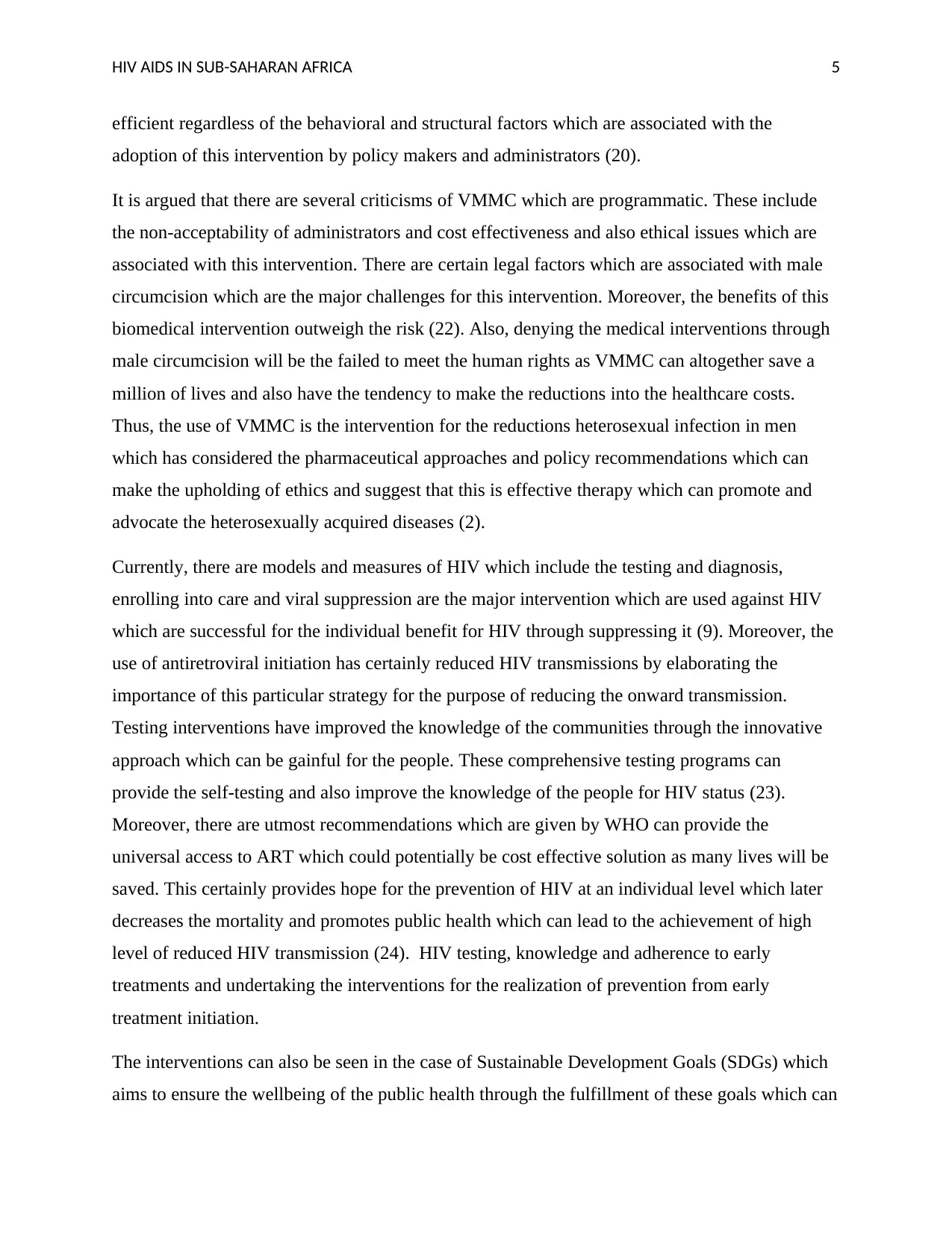
HIV AIDS IN SUB-SAHARAN AFRICA 5
efficient regardless of the behavioral and structural factors which are associated with the
adoption of this intervention by policy makers and administrators (20).
It is argued that there are several criticisms of VMMC which are programmatic. These include
the non-acceptability of administrators and cost effectiveness and also ethical issues which are
associated with this intervention. There are certain legal factors which are associated with male
circumcision which are the major challenges for this intervention. Moreover, the benefits of this
biomedical intervention outweigh the risk (22). Also, denying the medical interventions through
male circumcision will be the failed to meet the human rights as VMMC can altogether save a
million of lives and also have the tendency to make the reductions into the healthcare costs.
Thus, the use of VMMC is the intervention for the reductions heterosexual infection in men
which has considered the pharmaceutical approaches and policy recommendations which can
make the upholding of ethics and suggest that this is effective therapy which can promote and
advocate the heterosexually acquired diseases (2).
Currently, there are models and measures of HIV which include the testing and diagnosis,
enrolling into care and viral suppression are the major intervention which are used against HIV
which are successful for the individual benefit for HIV through suppressing it (9). Moreover, the
use of antiretroviral initiation has certainly reduced HIV transmissions by elaborating the
importance of this particular strategy for the purpose of reducing the onward transmission.
Testing interventions have improved the knowledge of the communities through the innovative
approach which can be gainful for the people. These comprehensive testing programs can
provide the self-testing and also improve the knowledge of the people for HIV status (23).
Moreover, there are utmost recommendations which are given by WHO can provide the
universal access to ART which could potentially be cost effective solution as many lives will be
saved. This certainly provides hope for the prevention of HIV at an individual level which later
decreases the mortality and promotes public health which can lead to the achievement of high
level of reduced HIV transmission (24). HIV testing, knowledge and adherence to early
treatments and undertaking the interventions for the realization of prevention from early
treatment initiation.
The interventions can also be seen in the case of Sustainable Development Goals (SDGs) which
aims to ensure the wellbeing of the public health through the fulfillment of these goals which can
efficient regardless of the behavioral and structural factors which are associated with the
adoption of this intervention by policy makers and administrators (20).
It is argued that there are several criticisms of VMMC which are programmatic. These include
the non-acceptability of administrators and cost effectiveness and also ethical issues which are
associated with this intervention. There are certain legal factors which are associated with male
circumcision which are the major challenges for this intervention. Moreover, the benefits of this
biomedical intervention outweigh the risk (22). Also, denying the medical interventions through
male circumcision will be the failed to meet the human rights as VMMC can altogether save a
million of lives and also have the tendency to make the reductions into the healthcare costs.
Thus, the use of VMMC is the intervention for the reductions heterosexual infection in men
which has considered the pharmaceutical approaches and policy recommendations which can
make the upholding of ethics and suggest that this is effective therapy which can promote and
advocate the heterosexually acquired diseases (2).
Currently, there are models and measures of HIV which include the testing and diagnosis,
enrolling into care and viral suppression are the major intervention which are used against HIV
which are successful for the individual benefit for HIV through suppressing it (9). Moreover, the
use of antiretroviral initiation has certainly reduced HIV transmissions by elaborating the
importance of this particular strategy for the purpose of reducing the onward transmission.
Testing interventions have improved the knowledge of the communities through the innovative
approach which can be gainful for the people. These comprehensive testing programs can
provide the self-testing and also improve the knowledge of the people for HIV status (23).
Moreover, there are utmost recommendations which are given by WHO can provide the
universal access to ART which could potentially be cost effective solution as many lives will be
saved. This certainly provides hope for the prevention of HIV at an individual level which later
decreases the mortality and promotes public health which can lead to the achievement of high
level of reduced HIV transmission (24). HIV testing, knowledge and adherence to early
treatments and undertaking the interventions for the realization of prevention from early
treatment initiation.
The interventions can also be seen in the case of Sustainable Development Goals (SDGs) which
aims to ensure the wellbeing of the public health through the fulfillment of these goals which can
⊘ This is a preview!⊘
Do you want full access?
Subscribe today to unlock all pages.

Trusted by 1+ million students worldwide
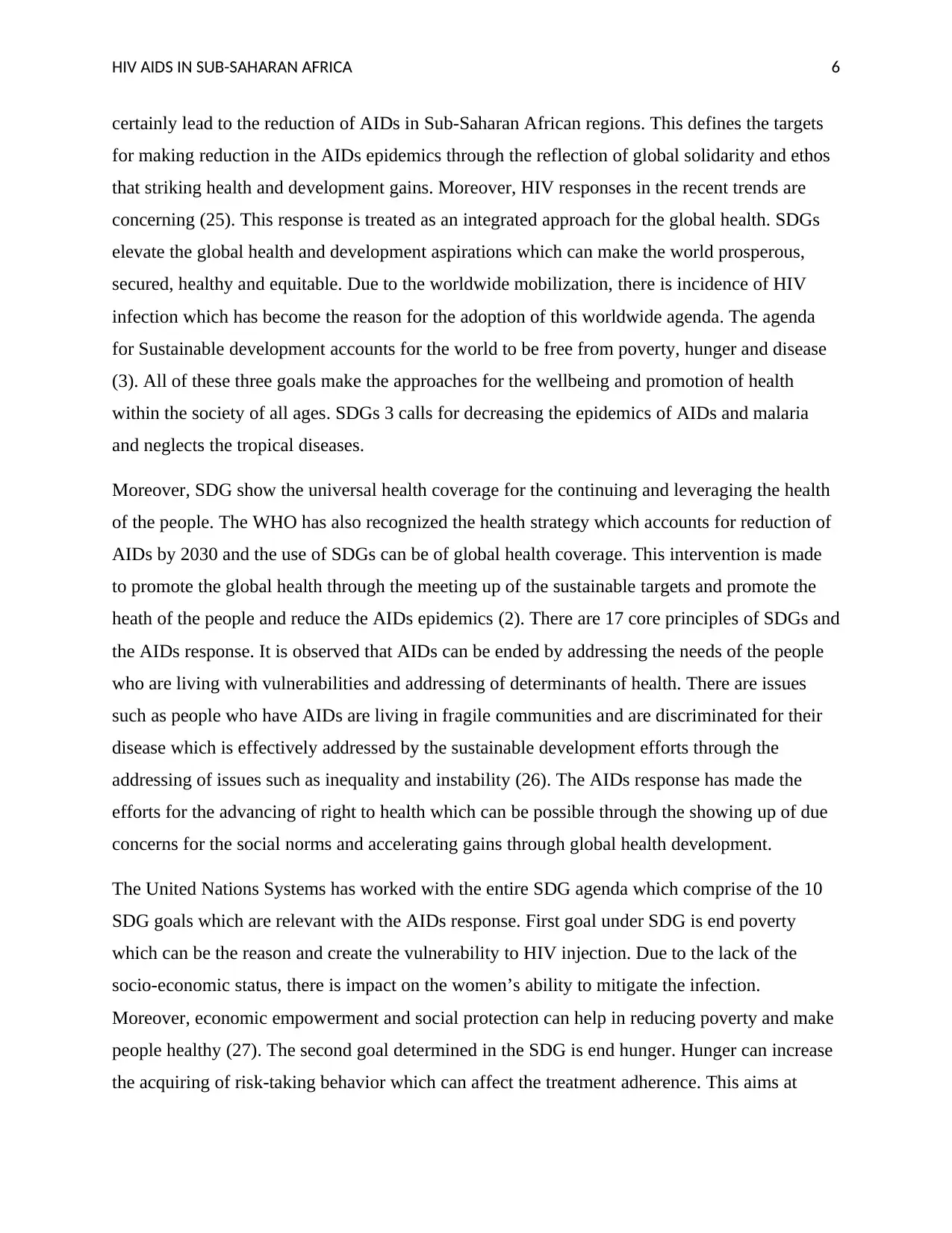
HIV AIDS IN SUB-SAHARAN AFRICA 6
certainly lead to the reduction of AIDs in Sub-Saharan African regions. This defines the targets
for making reduction in the AIDs epidemics through the reflection of global solidarity and ethos
that striking health and development gains. Moreover, HIV responses in the recent trends are
concerning (25). This response is treated as an integrated approach for the global health. SDGs
elevate the global health and development aspirations which can make the world prosperous,
secured, healthy and equitable. Due to the worldwide mobilization, there is incidence of HIV
infection which has become the reason for the adoption of this worldwide agenda. The agenda
for Sustainable development accounts for the world to be free from poverty, hunger and disease
(3). All of these three goals make the approaches for the wellbeing and promotion of health
within the society of all ages. SDGs 3 calls for decreasing the epidemics of AIDs and malaria
and neglects the tropical diseases.
Moreover, SDG show the universal health coverage for the continuing and leveraging the health
of the people. The WHO has also recognized the health strategy which accounts for reduction of
AIDs by 2030 and the use of SDGs can be of global health coverage. This intervention is made
to promote the global health through the meeting up of the sustainable targets and promote the
heath of the people and reduce the AIDs epidemics (2). There are 17 core principles of SDGs and
the AIDs response. It is observed that AIDs can be ended by addressing the needs of the people
who are living with vulnerabilities and addressing of determinants of health. There are issues
such as people who have AIDs are living in fragile communities and are discriminated for their
disease which is effectively addressed by the sustainable development efforts through the
addressing of issues such as inequality and instability (26). The AIDs response has made the
efforts for the advancing of right to health which can be possible through the showing up of due
concerns for the social norms and accelerating gains through global health development.
The United Nations Systems has worked with the entire SDG agenda which comprise of the 10
SDG goals which are relevant with the AIDs response. First goal under SDG is end poverty
which can be the reason and create the vulnerability to HIV injection. Due to the lack of the
socio-economic status, there is impact on the women’s ability to mitigate the infection.
Moreover, economic empowerment and social protection can help in reducing poverty and make
people healthy (27). The second goal determined in the SDG is end hunger. Hunger can increase
the acquiring of risk-taking behavior which can affect the treatment adherence. This aims at
certainly lead to the reduction of AIDs in Sub-Saharan African regions. This defines the targets
for making reduction in the AIDs epidemics through the reflection of global solidarity and ethos
that striking health and development gains. Moreover, HIV responses in the recent trends are
concerning (25). This response is treated as an integrated approach for the global health. SDGs
elevate the global health and development aspirations which can make the world prosperous,
secured, healthy and equitable. Due to the worldwide mobilization, there is incidence of HIV
infection which has become the reason for the adoption of this worldwide agenda. The agenda
for Sustainable development accounts for the world to be free from poverty, hunger and disease
(3). All of these three goals make the approaches for the wellbeing and promotion of health
within the society of all ages. SDGs 3 calls for decreasing the epidemics of AIDs and malaria
and neglects the tropical diseases.
Moreover, SDG show the universal health coverage for the continuing and leveraging the health
of the people. The WHO has also recognized the health strategy which accounts for reduction of
AIDs by 2030 and the use of SDGs can be of global health coverage. This intervention is made
to promote the global health through the meeting up of the sustainable targets and promote the
heath of the people and reduce the AIDs epidemics (2). There are 17 core principles of SDGs and
the AIDs response. It is observed that AIDs can be ended by addressing the needs of the people
who are living with vulnerabilities and addressing of determinants of health. There are issues
such as people who have AIDs are living in fragile communities and are discriminated for their
disease which is effectively addressed by the sustainable development efforts through the
addressing of issues such as inequality and instability (26). The AIDs response has made the
efforts for the advancing of right to health which can be possible through the showing up of due
concerns for the social norms and accelerating gains through global health development.
The United Nations Systems has worked with the entire SDG agenda which comprise of the 10
SDG goals which are relevant with the AIDs response. First goal under SDG is end poverty
which can be the reason and create the vulnerability to HIV injection. Due to the lack of the
socio-economic status, there is impact on the women’s ability to mitigate the infection.
Moreover, economic empowerment and social protection can help in reducing poverty and make
people healthy (27). The second goal determined in the SDG is end hunger. Hunger can increase
the acquiring of risk-taking behavior which can affect the treatment adherence. This aims at
Paraphrase This Document
Need a fresh take? Get an instant paraphrase of this document with our AI Paraphraser
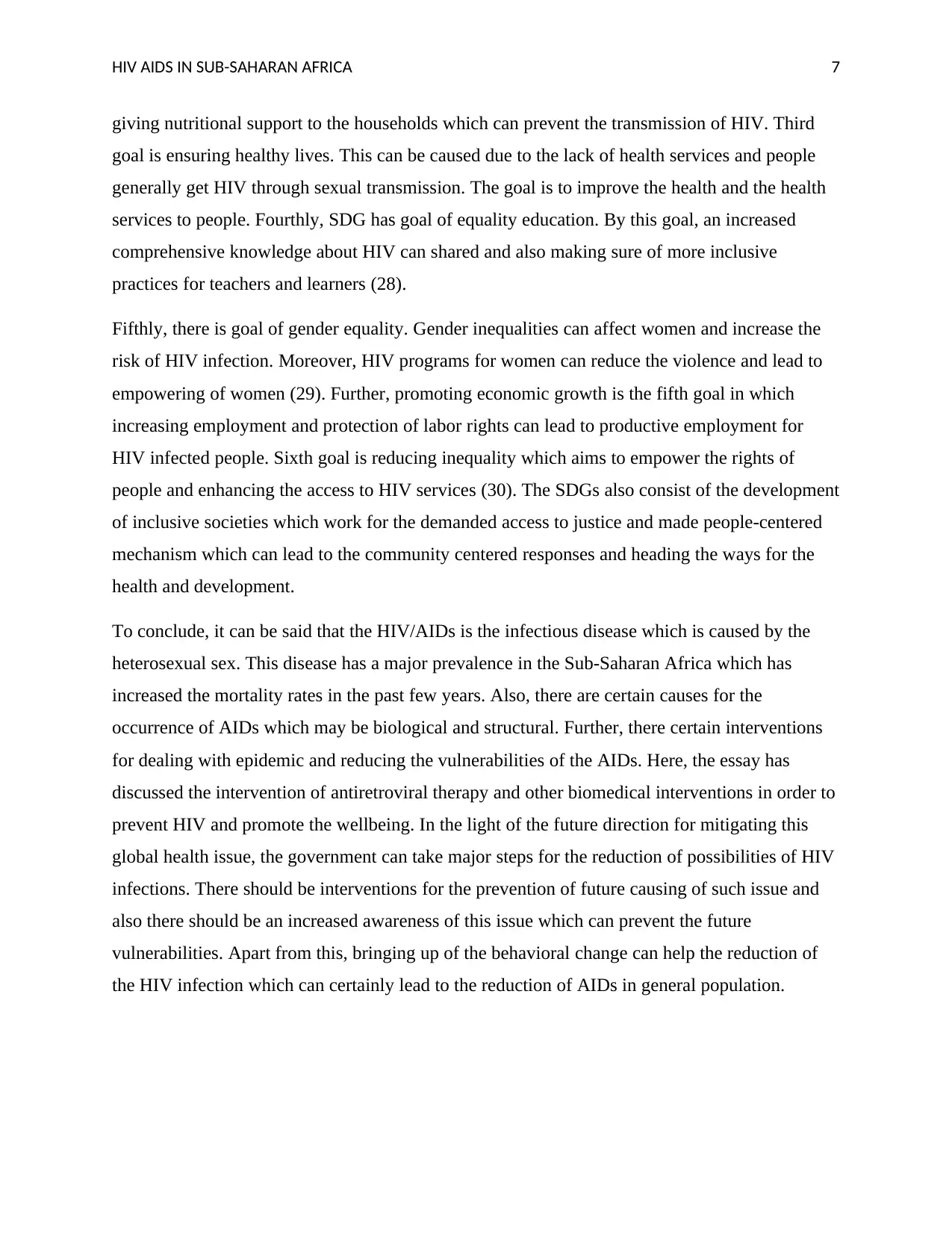
HIV AIDS IN SUB-SAHARAN AFRICA 7
giving nutritional support to the households which can prevent the transmission of HIV. Third
goal is ensuring healthy lives. This can be caused due to the lack of health services and people
generally get HIV through sexual transmission. The goal is to improve the health and the health
services to people. Fourthly, SDG has goal of equality education. By this goal, an increased
comprehensive knowledge about HIV can shared and also making sure of more inclusive
practices for teachers and learners (28).
Fifthly, there is goal of gender equality. Gender inequalities can affect women and increase the
risk of HIV infection. Moreover, HIV programs for women can reduce the violence and lead to
empowering of women (29). Further, promoting economic growth is the fifth goal in which
increasing employment and protection of labor rights can lead to productive employment for
HIV infected people. Sixth goal is reducing inequality which aims to empower the rights of
people and enhancing the access to HIV services (30). The SDGs also consist of the development
of inclusive societies which work for the demanded access to justice and made people-centered
mechanism which can lead to the community centered responses and heading the ways for the
health and development.
To conclude, it can be said that the HIV/AIDs is the infectious disease which is caused by the
heterosexual sex. This disease has a major prevalence in the Sub-Saharan Africa which has
increased the mortality rates in the past few years. Also, there are certain causes for the
occurrence of AIDs which may be biological and structural. Further, there certain interventions
for dealing with epidemic and reducing the vulnerabilities of the AIDs. Here, the essay has
discussed the intervention of antiretroviral therapy and other biomedical interventions in order to
prevent HIV and promote the wellbeing. In the light of the future direction for mitigating this
global health issue, the government can take major steps for the reduction of possibilities of HIV
infections. There should be interventions for the prevention of future causing of such issue and
also there should be an increased awareness of this issue which can prevent the future
vulnerabilities. Apart from this, bringing up of the behavioral change can help the reduction of
the HIV infection which can certainly lead to the reduction of AIDs in general population.
giving nutritional support to the households which can prevent the transmission of HIV. Third
goal is ensuring healthy lives. This can be caused due to the lack of health services and people
generally get HIV through sexual transmission. The goal is to improve the health and the health
services to people. Fourthly, SDG has goal of equality education. By this goal, an increased
comprehensive knowledge about HIV can shared and also making sure of more inclusive
practices for teachers and learners (28).
Fifthly, there is goal of gender equality. Gender inequalities can affect women and increase the
risk of HIV infection. Moreover, HIV programs for women can reduce the violence and lead to
empowering of women (29). Further, promoting economic growth is the fifth goal in which
increasing employment and protection of labor rights can lead to productive employment for
HIV infected people. Sixth goal is reducing inequality which aims to empower the rights of
people and enhancing the access to HIV services (30). The SDGs also consist of the development
of inclusive societies which work for the demanded access to justice and made people-centered
mechanism which can lead to the community centered responses and heading the ways for the
health and development.
To conclude, it can be said that the HIV/AIDs is the infectious disease which is caused by the
heterosexual sex. This disease has a major prevalence in the Sub-Saharan Africa which has
increased the mortality rates in the past few years. Also, there are certain causes for the
occurrence of AIDs which may be biological and structural. Further, there certain interventions
for dealing with epidemic and reducing the vulnerabilities of the AIDs. Here, the essay has
discussed the intervention of antiretroviral therapy and other biomedical interventions in order to
prevent HIV and promote the wellbeing. In the light of the future direction for mitigating this
global health issue, the government can take major steps for the reduction of possibilities of HIV
infections. There should be interventions for the prevention of future causing of such issue and
also there should be an increased awareness of this issue which can prevent the future
vulnerabilities. Apart from this, bringing up of the behavioral change can help the reduction of
the HIV infection which can certainly lead to the reduction of AIDs in general population.
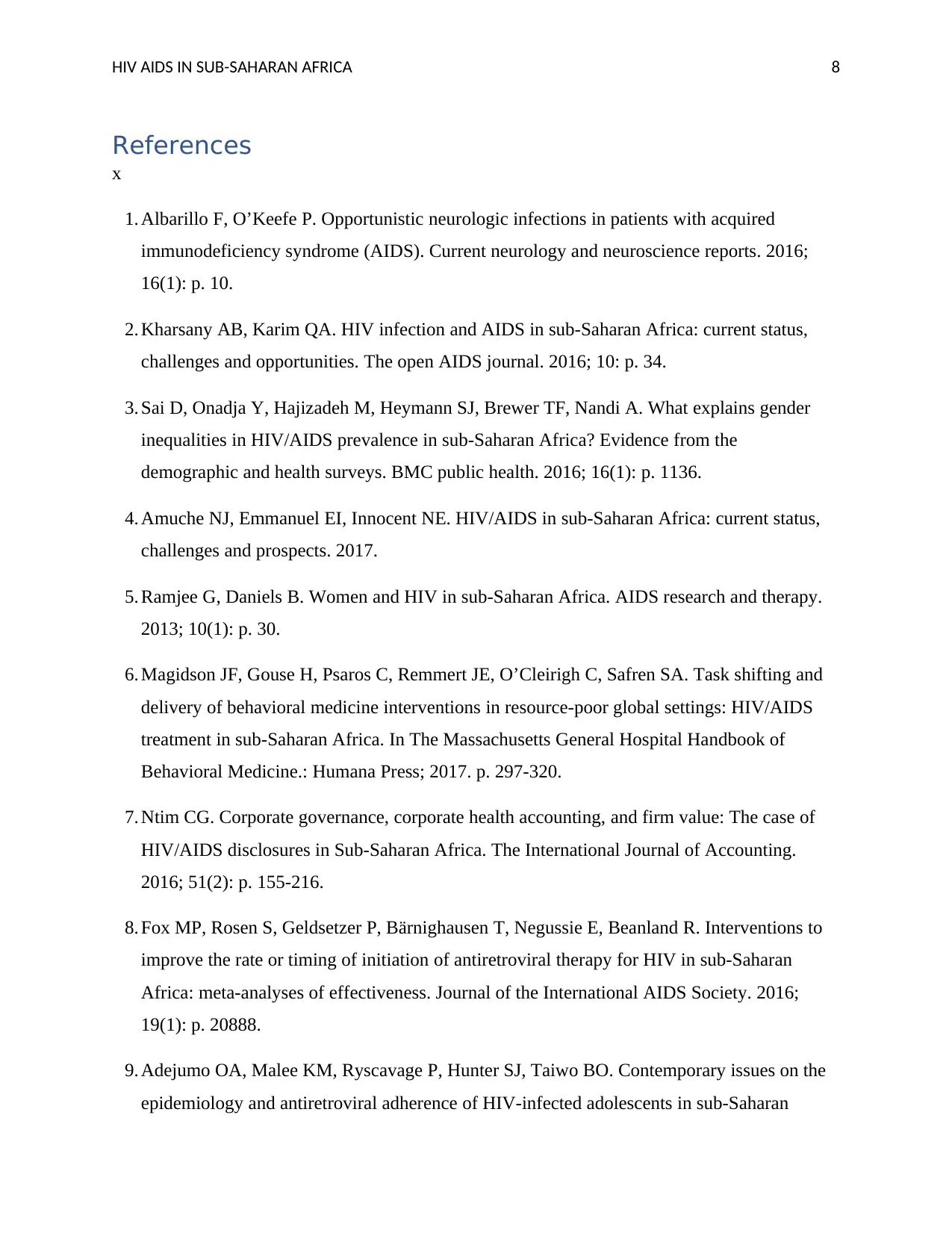
HIV AIDS IN SUB-SAHARAN AFRICA 8
References
x
1. Albarillo F, O’Keefe P. Opportunistic neurologic infections in patients with acquired
immunodeficiency syndrome (AIDS). Current neurology and neuroscience reports. 2016;
16(1): p. 10.
2. Kharsany AB, Karim QA. HIV infection and AIDS in sub-Saharan Africa: current status,
challenges and opportunities. The open AIDS journal. 2016; 10: p. 34.
3. Sai D, Onadja Y, Hajizadeh M, Heymann SJ, Brewer TF, Nandi A. What explains gender
inequalities in HIV/AIDS prevalence in sub-Saharan Africa? Evidence from the
demographic and health surveys. BMC public health. 2016; 16(1): p. 1136.
4. Amuche NJ, Emmanuel EI, Innocent NE. HIV/AIDS in sub-Saharan Africa: current status,
challenges and prospects. 2017.
5. Ramjee G, Daniels B. Women and HIV in sub-Saharan Africa. AIDS research and therapy.
2013; 10(1): p. 30.
6. Magidson JF, Gouse H, Psaros C, Remmert JE, O’Cleirigh C, Safren SA. Task shifting and
delivery of behavioral medicine interventions in resource-poor global settings: HIV/AIDS
treatment in sub-Saharan Africa. In The Massachusetts General Hospital Handbook of
Behavioral Medicine.: Humana Press; 2017. p. 297-320.
7. Ntim CG. Corporate governance, corporate health accounting, and firm value: The case of
HIV/AIDS disclosures in Sub-Saharan Africa. The International Journal of Accounting.
2016; 51(2): p. 155-216.
8. Fox MP, Rosen S, Geldsetzer P, Bärnighausen T, Negussie E, Beanland R. Interventions to
improve the rate or timing of initiation of antiretroviral therapy for HIV in sub‐Saharan
Africa: meta‐analyses of effectiveness. Journal of the International AIDS Society. 2016;
19(1): p. 20888.
9. Adejumo OA, Malee KM, Ryscavage P, Hunter SJ, Taiwo BO. Contemporary issues on the
epidemiology and antiretroviral adherence of HIV‐infected adolescents in sub‐Saharan
References
x
1. Albarillo F, O’Keefe P. Opportunistic neurologic infections in patients with acquired
immunodeficiency syndrome (AIDS). Current neurology and neuroscience reports. 2016;
16(1): p. 10.
2. Kharsany AB, Karim QA. HIV infection and AIDS in sub-Saharan Africa: current status,
challenges and opportunities. The open AIDS journal. 2016; 10: p. 34.
3. Sai D, Onadja Y, Hajizadeh M, Heymann SJ, Brewer TF, Nandi A. What explains gender
inequalities in HIV/AIDS prevalence in sub-Saharan Africa? Evidence from the
demographic and health surveys. BMC public health. 2016; 16(1): p. 1136.
4. Amuche NJ, Emmanuel EI, Innocent NE. HIV/AIDS in sub-Saharan Africa: current status,
challenges and prospects. 2017.
5. Ramjee G, Daniels B. Women and HIV in sub-Saharan Africa. AIDS research and therapy.
2013; 10(1): p. 30.
6. Magidson JF, Gouse H, Psaros C, Remmert JE, O’Cleirigh C, Safren SA. Task shifting and
delivery of behavioral medicine interventions in resource-poor global settings: HIV/AIDS
treatment in sub-Saharan Africa. In The Massachusetts General Hospital Handbook of
Behavioral Medicine.: Humana Press; 2017. p. 297-320.
7. Ntim CG. Corporate governance, corporate health accounting, and firm value: The case of
HIV/AIDS disclosures in Sub-Saharan Africa. The International Journal of Accounting.
2016; 51(2): p. 155-216.
8. Fox MP, Rosen S, Geldsetzer P, Bärnighausen T, Negussie E, Beanland R. Interventions to
improve the rate or timing of initiation of antiretroviral therapy for HIV in sub‐Saharan
Africa: meta‐analyses of effectiveness. Journal of the International AIDS Society. 2016;
19(1): p. 20888.
9. Adejumo OA, Malee KM, Ryscavage P, Hunter SJ, Taiwo BO. Contemporary issues on the
epidemiology and antiretroviral adherence of HIV‐infected adolescents in sub‐Saharan
⊘ This is a preview!⊘
Do you want full access?
Subscribe today to unlock all pages.

Trusted by 1+ million students worldwide
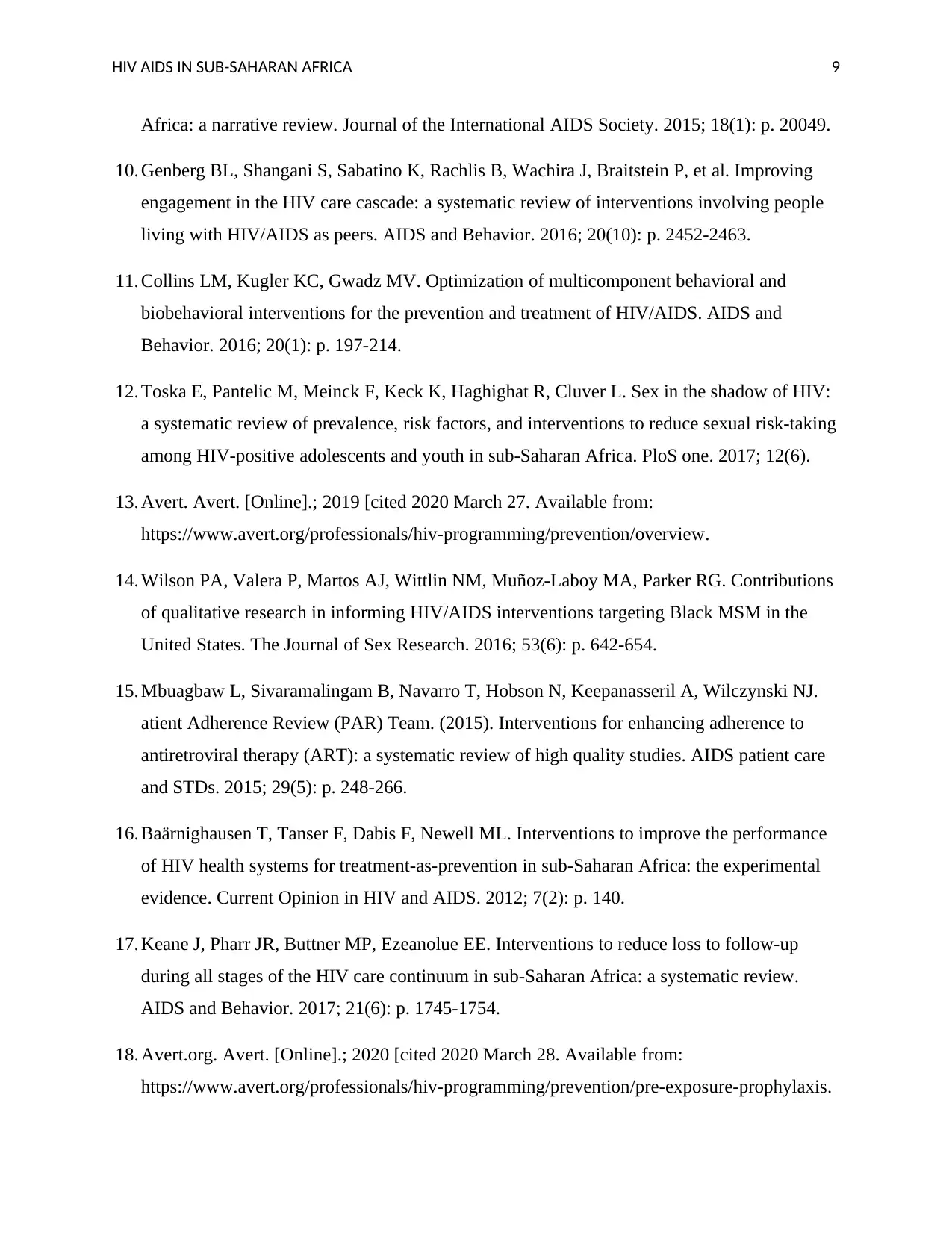
HIV AIDS IN SUB-SAHARAN AFRICA 9
Africa: a narrative review. Journal of the International AIDS Society. 2015; 18(1): p. 20049.
10. Genberg BL, Shangani S, Sabatino K, Rachlis B, Wachira J, Braitstein P, et al. Improving
engagement in the HIV care cascade: a systematic review of interventions involving people
living with HIV/AIDS as peers. AIDS and Behavior. 2016; 20(10): p. 2452-2463.
11. Collins LM, Kugler KC, Gwadz MV. Optimization of multicomponent behavioral and
biobehavioral interventions for the prevention and treatment of HIV/AIDS. AIDS and
Behavior. 2016; 20(1): p. 197-214.
12. Toska E, Pantelic M, Meinck F, Keck K, Haghighat R, Cluver L. Sex in the shadow of HIV:
a systematic review of prevalence, risk factors, and interventions to reduce sexual risk-taking
among HIV-positive adolescents and youth in sub-Saharan Africa. PloS one. 2017; 12(6).
13. Avert. Avert. [Online].; 2019 [cited 2020 March 27. Available from:
https://www.avert.org/professionals/hiv-programming/prevention/overview.
14. Wilson PA, Valera P, Martos AJ, Wittlin NM, Muñoz-Laboy MA, Parker RG. Contributions
of qualitative research in informing HIV/AIDS interventions targeting Black MSM in the
United States. The Journal of Sex Research. 2016; 53(6): p. 642-654.
15. Mbuagbaw L, Sivaramalingam B, Navarro T, Hobson N, Keepanasseril A, Wilczynski NJ.
atient Adherence Review (PAR) Team. (2015). Interventions for enhancing adherence to
antiretroviral therapy (ART): a systematic review of high quality studies. AIDS patient care
and STDs. 2015; 29(5): p. 248-266.
16. Baärnighausen T, Tanser F, Dabis F, Newell ML. Interventions to improve the performance
of HIV health systems for treatment-as-prevention in sub-Saharan Africa: the experimental
evidence. Current Opinion in HIV and AIDS. 2012; 7(2): p. 140.
17. Keane J, Pharr JR, Buttner MP, Ezeanolue EE. Interventions to reduce loss to follow-up
during all stages of the HIV care continuum in sub-Saharan Africa: a systematic review.
AIDS and Behavior. 2017; 21(6): p. 1745-1754.
18. Avert.org. Avert. [Online].; 2020 [cited 2020 March 28. Available from:
https://www.avert.org/professionals/hiv-programming/prevention/pre-exposure-prophylaxis.
Africa: a narrative review. Journal of the International AIDS Society. 2015; 18(1): p. 20049.
10. Genberg BL, Shangani S, Sabatino K, Rachlis B, Wachira J, Braitstein P, et al. Improving
engagement in the HIV care cascade: a systematic review of interventions involving people
living with HIV/AIDS as peers. AIDS and Behavior. 2016; 20(10): p. 2452-2463.
11. Collins LM, Kugler KC, Gwadz MV. Optimization of multicomponent behavioral and
biobehavioral interventions for the prevention and treatment of HIV/AIDS. AIDS and
Behavior. 2016; 20(1): p. 197-214.
12. Toska E, Pantelic M, Meinck F, Keck K, Haghighat R, Cluver L. Sex in the shadow of HIV:
a systematic review of prevalence, risk factors, and interventions to reduce sexual risk-taking
among HIV-positive adolescents and youth in sub-Saharan Africa. PloS one. 2017; 12(6).
13. Avert. Avert. [Online].; 2019 [cited 2020 March 27. Available from:
https://www.avert.org/professionals/hiv-programming/prevention/overview.
14. Wilson PA, Valera P, Martos AJ, Wittlin NM, Muñoz-Laboy MA, Parker RG. Contributions
of qualitative research in informing HIV/AIDS interventions targeting Black MSM in the
United States. The Journal of Sex Research. 2016; 53(6): p. 642-654.
15. Mbuagbaw L, Sivaramalingam B, Navarro T, Hobson N, Keepanasseril A, Wilczynski NJ.
atient Adherence Review (PAR) Team. (2015). Interventions for enhancing adherence to
antiretroviral therapy (ART): a systematic review of high quality studies. AIDS patient care
and STDs. 2015; 29(5): p. 248-266.
16. Baärnighausen T, Tanser F, Dabis F, Newell ML. Interventions to improve the performance
of HIV health systems for treatment-as-prevention in sub-Saharan Africa: the experimental
evidence. Current Opinion in HIV and AIDS. 2012; 7(2): p. 140.
17. Keane J, Pharr JR, Buttner MP, Ezeanolue EE. Interventions to reduce loss to follow-up
during all stages of the HIV care continuum in sub-Saharan Africa: a systematic review.
AIDS and Behavior. 2017; 21(6): p. 1745-1754.
18. Avert.org. Avert. [Online].; 2020 [cited 2020 March 28. Available from:
https://www.avert.org/professionals/hiv-programming/prevention/pre-exposure-prophylaxis.
Paraphrase This Document
Need a fresh take? Get an instant paraphrase of this document with our AI Paraphraser
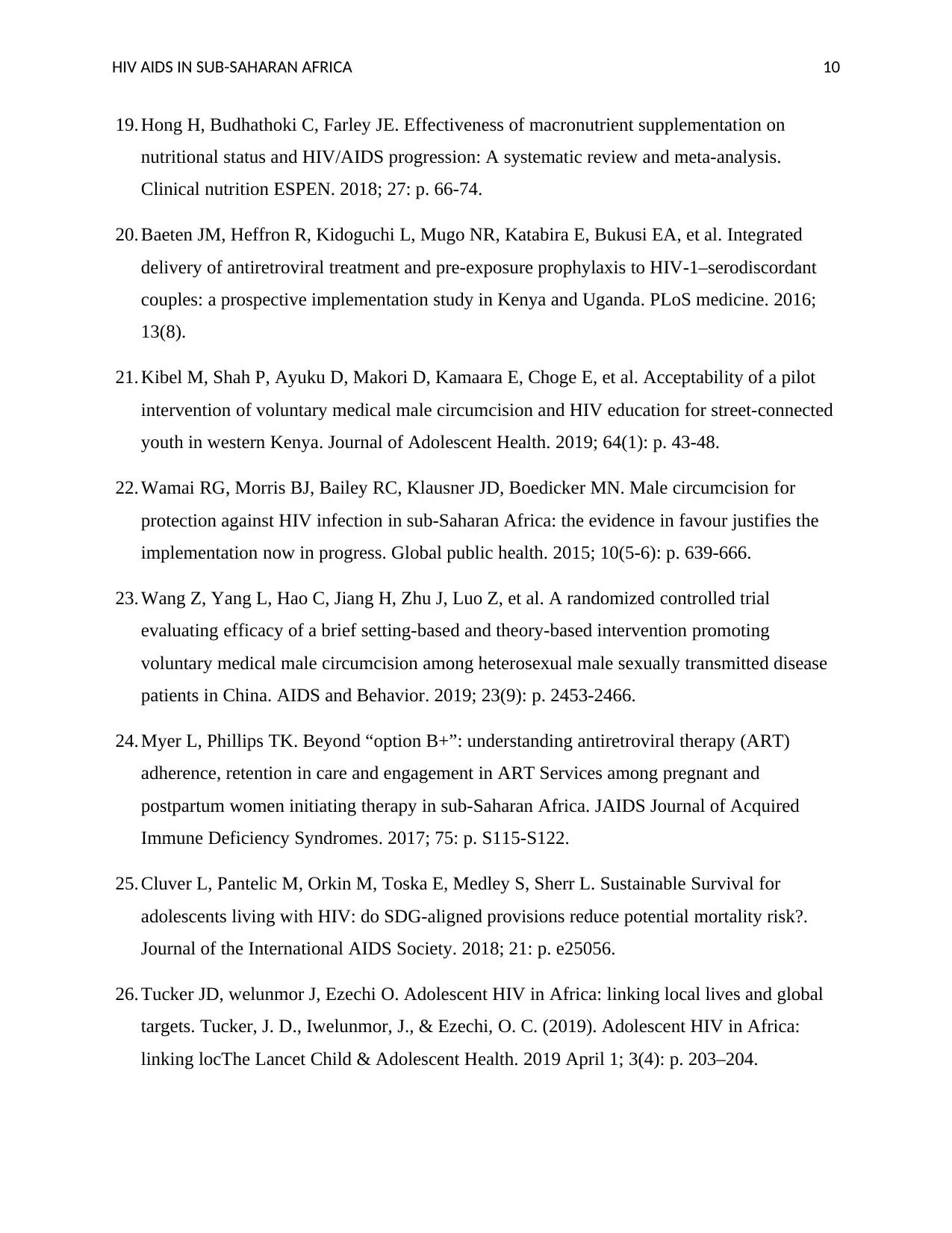
HIV AIDS IN SUB-SAHARAN AFRICA 10
19. Hong H, Budhathoki C, Farley JE. Effectiveness of macronutrient supplementation on
nutritional status and HIV/AIDS progression: A systematic review and meta-analysis.
Clinical nutrition ESPEN. 2018; 27: p. 66-74.
20. Baeten JM, Heffron R, Kidoguchi L, Mugo NR, Katabira E, Bukusi EA, et al. Integrated
delivery of antiretroviral treatment and pre-exposure prophylaxis to HIV-1–serodiscordant
couples: a prospective implementation study in Kenya and Uganda. PLoS medicine. 2016;
13(8).
21. Kibel M, Shah P, Ayuku D, Makori D, Kamaara E, Choge E, et al. Acceptability of a pilot
intervention of voluntary medical male circumcision and HIV education for street-connected
youth in western Kenya. Journal of Adolescent Health. 2019; 64(1): p. 43-48.
22. Wamai RG, Morris BJ, Bailey RC, Klausner JD, Boedicker MN. Male circumcision for
protection against HIV infection in sub-Saharan Africa: the evidence in favour justifies the
implementation now in progress. Global public health. 2015; 10(5-6): p. 639-666.
23. Wang Z, Yang L, Hao C, Jiang H, Zhu J, Luo Z, et al. A randomized controlled trial
evaluating efficacy of a brief setting-based and theory-based intervention promoting
voluntary medical male circumcision among heterosexual male sexually transmitted disease
patients in China. AIDS and Behavior. 2019; 23(9): p. 2453-2466.
24. Myer L, Phillips TK. Beyond “option B+”: understanding antiretroviral therapy (ART)
adherence, retention in care and engagement in ART Services among pregnant and
postpartum women initiating therapy in sub-Saharan Africa. JAIDS Journal of Acquired
Immune Deficiency Syndromes. 2017; 75: p. S115-S122.
25. Cluver L, Pantelic M, Orkin M, Toska E, Medley S, Sherr L. Sustainable Survival for
adolescents living with HIV: do SDG‐aligned provisions reduce potential mortality risk?.
Journal of the International AIDS Society. 2018; 21: p. e25056.
26. Tucker JD, welunmor J, Ezechi O. Adolescent HIV in Africa: linking local lives and global
targets. Tucker, J. D., Iwelunmor, J., & Ezechi, O. C. (2019). Adolescent HIV in Africa:
linking locThe Lancet Child & Adolescent Health. 2019 April 1; 3(4): p. 203–204.
19. Hong H, Budhathoki C, Farley JE. Effectiveness of macronutrient supplementation on
nutritional status and HIV/AIDS progression: A systematic review and meta-analysis.
Clinical nutrition ESPEN. 2018; 27: p. 66-74.
20. Baeten JM, Heffron R, Kidoguchi L, Mugo NR, Katabira E, Bukusi EA, et al. Integrated
delivery of antiretroviral treatment and pre-exposure prophylaxis to HIV-1–serodiscordant
couples: a prospective implementation study in Kenya and Uganda. PLoS medicine. 2016;
13(8).
21. Kibel M, Shah P, Ayuku D, Makori D, Kamaara E, Choge E, et al. Acceptability of a pilot
intervention of voluntary medical male circumcision and HIV education for street-connected
youth in western Kenya. Journal of Adolescent Health. 2019; 64(1): p. 43-48.
22. Wamai RG, Morris BJ, Bailey RC, Klausner JD, Boedicker MN. Male circumcision for
protection against HIV infection in sub-Saharan Africa: the evidence in favour justifies the
implementation now in progress. Global public health. 2015; 10(5-6): p. 639-666.
23. Wang Z, Yang L, Hao C, Jiang H, Zhu J, Luo Z, et al. A randomized controlled trial
evaluating efficacy of a brief setting-based and theory-based intervention promoting
voluntary medical male circumcision among heterosexual male sexually transmitted disease
patients in China. AIDS and Behavior. 2019; 23(9): p. 2453-2466.
24. Myer L, Phillips TK. Beyond “option B+”: understanding antiretroviral therapy (ART)
adherence, retention in care and engagement in ART Services among pregnant and
postpartum women initiating therapy in sub-Saharan Africa. JAIDS Journal of Acquired
Immune Deficiency Syndromes. 2017; 75: p. S115-S122.
25. Cluver L, Pantelic M, Orkin M, Toska E, Medley S, Sherr L. Sustainable Survival for
adolescents living with HIV: do SDG‐aligned provisions reduce potential mortality risk?.
Journal of the International AIDS Society. 2018; 21: p. e25056.
26. Tucker JD, welunmor J, Ezechi O. Adolescent HIV in Africa: linking local lives and global
targets. Tucker, J. D., Iwelunmor, J., & Ezechi, O. C. (2019). Adolescent HIV in Africa:
linking locThe Lancet Child & Adolescent Health. 2019 April 1; 3(4): p. 203–204.
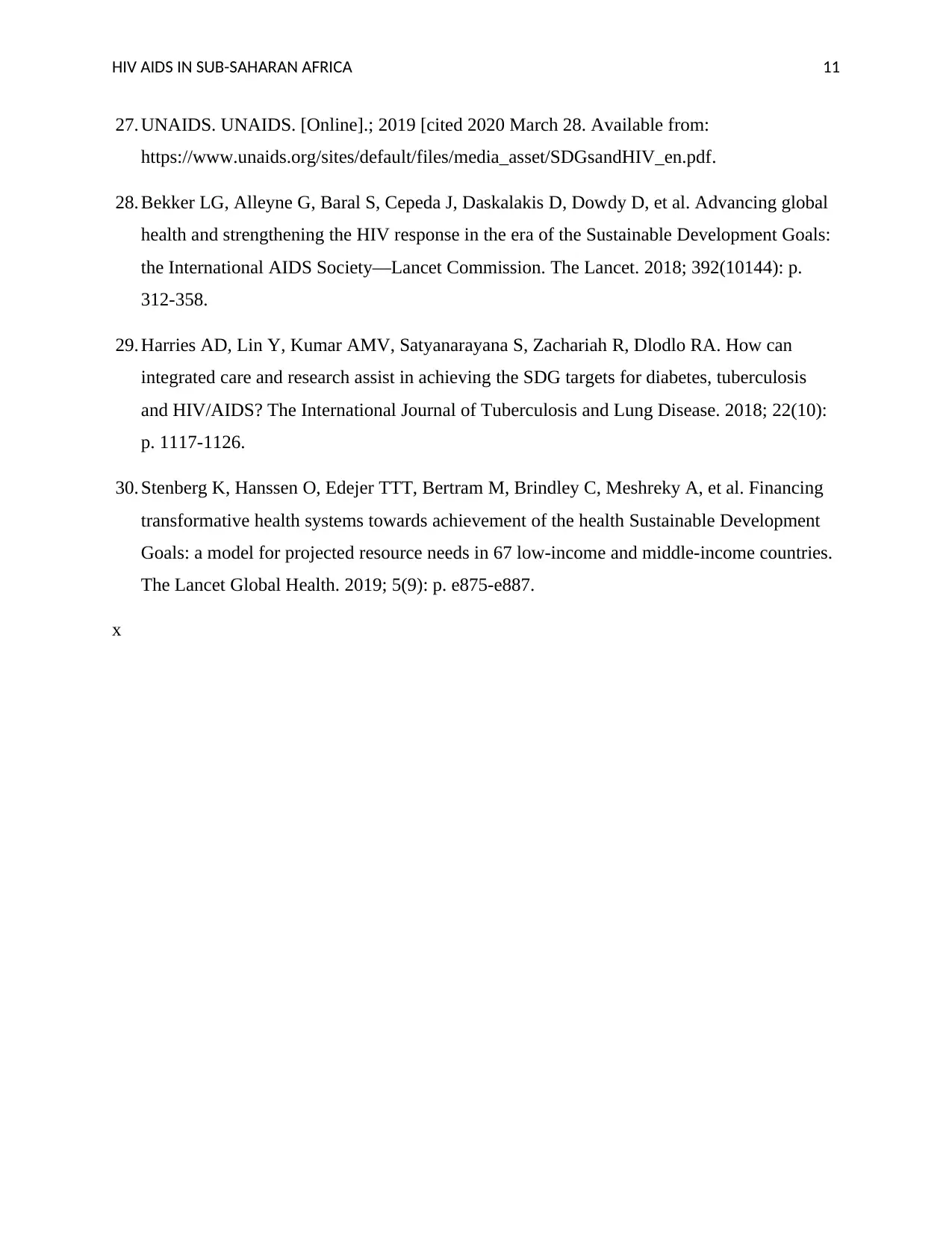
HIV AIDS IN SUB-SAHARAN AFRICA 11
27. UNAIDS. UNAIDS. [Online].; 2019 [cited 2020 March 28. Available from:
https://www.unaids.org/sites/default/files/media_asset/SDGsandHIV_en.pdf.
28. Bekker LG, Alleyne G, Baral S, Cepeda J, Daskalakis D, Dowdy D, et al. Advancing global
health and strengthening the HIV response in the era of the Sustainable Development Goals:
the International AIDS Society—Lancet Commission. The Lancet. 2018; 392(10144): p.
312-358.
29. Harries AD, Lin Y, Kumar AMV, Satyanarayana S, Zachariah R, Dlodlo RA. How can
integrated care and research assist in achieving the SDG targets for diabetes, tuberculosis
and HIV/AIDS? The International Journal of Tuberculosis and Lung Disease. 2018; 22(10):
p. 1117-1126.
30. Stenberg K, Hanssen O, Edejer TTT, Bertram M, Brindley C, Meshreky A, et al. Financing
transformative health systems towards achievement of the health Sustainable Development
Goals: a model for projected resource needs in 67 low-income and middle-income countries.
The Lancet Global Health. 2019; 5(9): p. e875-e887.
x
27. UNAIDS. UNAIDS. [Online].; 2019 [cited 2020 March 28. Available from:
https://www.unaids.org/sites/default/files/media_asset/SDGsandHIV_en.pdf.
28. Bekker LG, Alleyne G, Baral S, Cepeda J, Daskalakis D, Dowdy D, et al. Advancing global
health and strengthening the HIV response in the era of the Sustainable Development Goals:
the International AIDS Society—Lancet Commission. The Lancet. 2018; 392(10144): p.
312-358.
29. Harries AD, Lin Y, Kumar AMV, Satyanarayana S, Zachariah R, Dlodlo RA. How can
integrated care and research assist in achieving the SDG targets for diabetes, tuberculosis
and HIV/AIDS? The International Journal of Tuberculosis and Lung Disease. 2018; 22(10):
p. 1117-1126.
30. Stenberg K, Hanssen O, Edejer TTT, Bertram M, Brindley C, Meshreky A, et al. Financing
transformative health systems towards achievement of the health Sustainable Development
Goals: a model for projected resource needs in 67 low-income and middle-income countries.
The Lancet Global Health. 2019; 5(9): p. e875-e887.
x
⊘ This is a preview!⊘
Do you want full access?
Subscribe today to unlock all pages.

Trusted by 1+ million students worldwide
1 out of 12
Related Documents
Your All-in-One AI-Powered Toolkit for Academic Success.
+13062052269
info@desklib.com
Available 24*7 on WhatsApp / Email
![[object Object]](/_next/static/media/star-bottom.7253800d.svg)
Unlock your academic potential
Copyright © 2020–2025 A2Z Services. All Rights Reserved. Developed and managed by ZUCOL.





